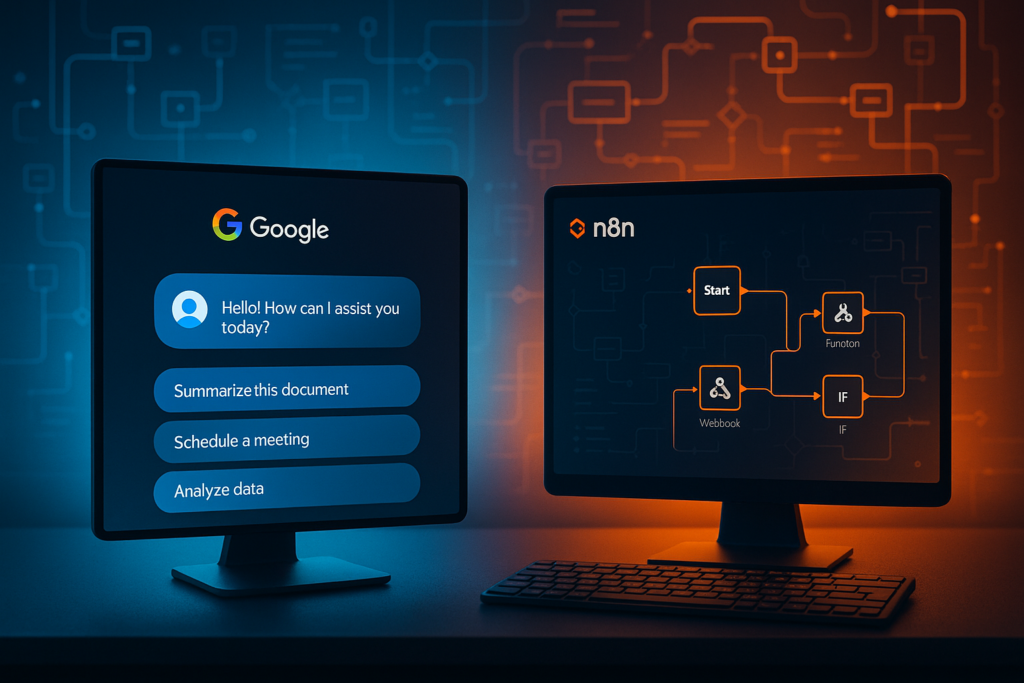Introduction: The Great Divide in AI Workflow
Google Opal vs N8N: The automation world is changing fast. Today, two very different philosophies dominate the space:
- Google Opal, built for simplicity, anyone can describe what they want in plain English, and the AI does the rest.
- n8n, built for control, it gives developers a playground to build complex, custom, and self-hosted workflows.
So the real question isn’t which tool is better, but which one is better for you.
Opal’s mission is to make AI app creation accessible to non-technical users, perfect for teams that just want results without coding.
Meanwhile, n8n empowers developers and enterprises who need precision, flexibility, and ownership of their automation logic and data.
Let’s break down how these two tools compare in usability, customization, and real-world deployment.
Usability and Interface Comparison
Conversational Simplicity (Google Opal)
Imagine describing your workflow like you’d talk to a colleague:
“Send a summary of today’s emails to Slack, and create a Trello card if something is marked urgent.”
That’s exactly what Google Opal does. You speak (or type) what you want, and the AI automatically builds your flow visually.
It’s intuitive, beginner-friendly, and requires zero setup. Perfect for marketers, content creators, or business users who want quick automations without diving into code or logic trees.
✅ Best for: non-technical users, quick prototypes, and creative AI experiments.
Node-Based Logic (n8n)
n8n takes the opposite approach. It gives you a node-based UI, a visual editor where each node represents an action, trigger, or condition.
It’s more technical, yes, but also much more powerful. Developers can handle complex workflows, add custom code, and integrate APIs from nearly any platform.
Think of it as an automation “command center”, where you can see, debug, and refine every single step.
✅ Best for: developers, automation engineers, and teams that need deep logic and control.
Control, Customization, and Complexity
Handling Multi-Step and Complex Workflows
If your automation involves multiple branches, loops, or conditional paths, n8n is built for that.
You can create layered, multi-step processes that integrate multiple APIs and data streams, all inside your own environment.
Google Opal, on the other hand, keeps things simple. It’s great for linear or straightforward automations, but it struggles with highly branched or conditional logic.
✅ Verdict:
- Google Opal → great for simple, single-purpose flows.
- n8n → unbeatable for complex, multi-layered workflows.
Deep API Integrations and Flexibility
n8n offers hundreds of built-in integrations, supports REST and GraphQL, and even lets you code custom nodes.
That means you can connect anything, CRMs, databases, or internal APIs, all while keeping full developer control.
Meanwhile, Google Opal is still young. It mainly supports Google ecosystem tools like Gmail, YouTube, and Drive. Integrating third-party services often requires manual setup or API registration.
✅ Verdict:
- n8n: deep, flexible integrations for serious developers.
- Opal: quick and easy, but limited beyond Google apps.
Deployment and Data Sovereignty
Open-Source Flexibility and Self-Hosting (n8n)
One of n8n’s biggest strengths is its open-source nature. You can self-host it anywhere, your cloud, your server, or even locally.
This means:
- Full data control
- Complete customization
- Better security for sensitive information
For enterprises and automation companies, that’s a dealbreaker advantage.
Vendor Dependence and “Experimental” Status (Google Opal)
Google Opal is still in Google Labs, which means it’s experimental. You can’t self-host it, and it fully relies on Google’s infrastructure.
While that makes setup easy, it also means:
- You depend on Google’s ecosystem
- You can’t access your workflow data directly
- Future pricing or feature changes could affect your setup
✅ Verdict:
If data ownership, compliance, and customization matter → n8n wins hands down.
Conclusion: Which Platform Should You Choose?
Let’s make it simple 👇
| User Type | Best Choice | Why |
|---|---|---|
| 🧍♂️ Non-technical users | Google Opal | Fast setup, conversational UI, no coding needed |
| 👨💻 Developers / Engineers | n8n | Full control, self-hosting, advanced logic |
| 🏢 Enterprises | n8n | Secure, scalable, open-source flexibility |
| 💡 Creators / Marketers | Google Opal | Great for quick prototypes & creative workflows |
✅ Final Verdict
If you want speed, simplicity, and creativity, go with Google Opal.
If you want power, flexibility, and total control, n8n is the clear winner.
Both tools are shaping the future of automation, one through conversation, and the other through control.
